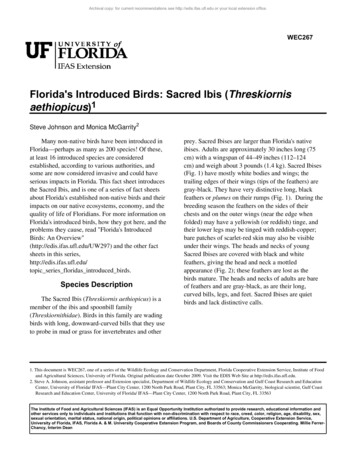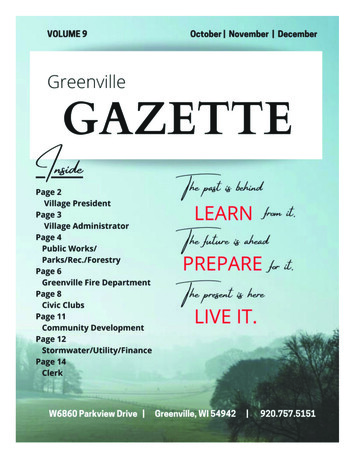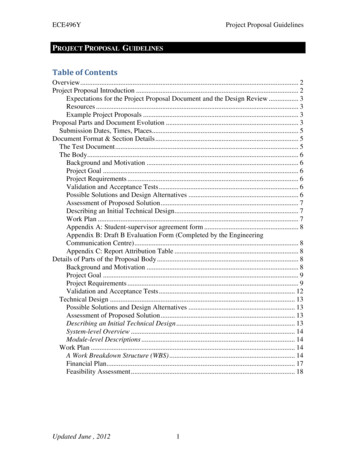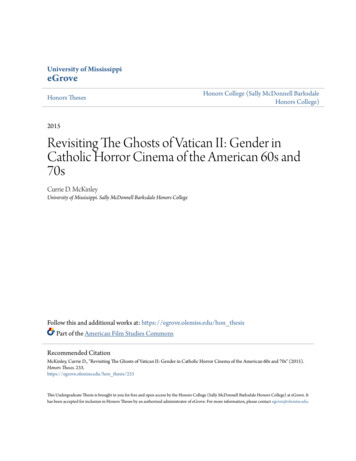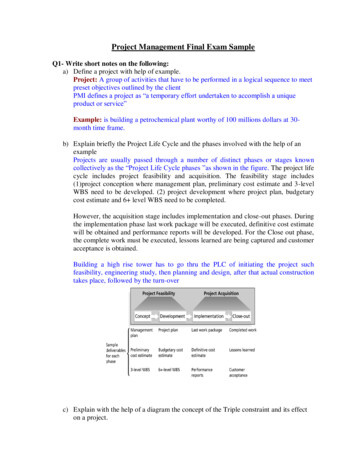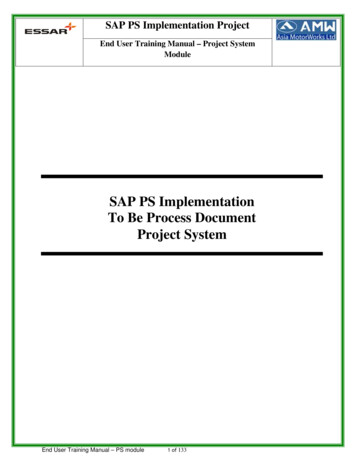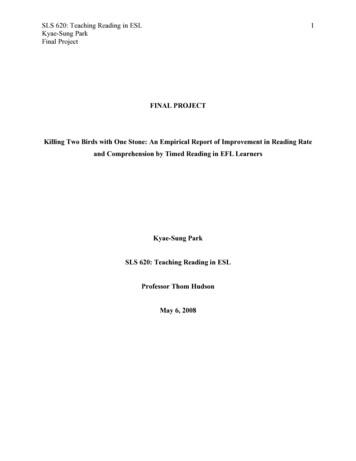
Transcription
SLS 620: Teaching Reading in ESLKyae-Sung ParkFinal Project1FINAL PROJECTKilling Two Birds with One Stone: An Empirical Report of Improvement in Reading Rateand Comprehension by Timed Reading in EFL LearnersKyae-Sung ParkSLS 620: Teaching Reading in ESLProfessor Thom HudsonMay 6, 2008
SLS 620: Teaching Reading in ESLKyae-Sung ParkFinal Project2ABSTRACTThis study investigates whether EFL learners can improve their reading rates and comprehensionby timed reading. The results showed a significant improvement (an increase) in reading rate inthe slow readers and in comprehension in the fast readers as well as slow readers, indicating thattimed reading followed by a comprehension test was beneficial for second and foreign languagereaders in improving their comprehension as well as reading rates.1. INTRODUCTIONAtuomaticity theory (LaBerge and Samuels, 1974) considers reading as a dual-levelprocess, involving letter-decoding and text-comprehending. As readers decode letters morerapidly and effortlessly, their attention paid to letter-decoding and text-comprehension separatelycan be more converged for text-comprehension. The theory emphasizes that the role of repetitionthrough extensive practice is at the center. Training in decoding known words repeatedly at theperceptual lever over time enables readers to read the text more rapidly with less attention, andmore attention can be available for a full understanding of the content.There has been a substantial body of research on automaticity in the first language (L1)reading literature, while scant attention has been paid to automaticity in second and foreignlanguage (L2) reading. This lack of study on fluency in L2 reading can be detected in Hudson’smost recent extensive, thorough review of L1 and L2 reading literature (2007), where the topicsof automaticity, fluency, or reading rate in L2 reading are excluded. Presumably, it is partiallyattributed to the late emergence of L2 reading studies as compared to L1 reading studies. UnlikeL1 reading that has observed a series of changes in the trend of theories, approaches, and modelsfrom bottom-up to new literacy over the past two decades, L2 reading might not have dealt withall issues that were being covered in L1 reading due to its short literature history. When L2reading was on the verge of emergence, L1 reading turned its attention toward New Literacy afterundergoing a period of intense interest in automaticity between the 1970s and the early 1990s. Inaddition, New Literacy focuses on “a social and anthropological approach to reading that deemphasizes the role of the AUTONOMOUS READER (Hudson, 2007, 55).” As a consequence,automaticity theory missed its timing to be placed at the center and be empirically tested in L2reading.The purpose of the current study is to investigate whether L2 readers, especially in EFLcontext are able to improve their reading rates and comprehension by timed reading over a
SLS 620: Teaching Reading in ESLKyae-Sung ParkFinal Project3period of one month (three months in the original proposal) on a regular basis. Although ourstudy is primarily concerned with fluency, which is related to automaticity theory, our focus ison raising awareness of fluency by timed reading, not by repeated reading.2. LITERATURE REVIEWTo our knowledge, there are only four studies on reading rate in the L2 reading literature,Taguchi (1997), Taguchi & Gorsuch (2002), Taguchi, Takayasu-Maass, & Gorsuch (2004), andDay & Hill (To appear). Taguchi (1997), for the first time in L2 reading, conducted an assistedrepeated reading study with 15 Japanese university students. The participants had 30-minutes ofassisted repeated reading training three times per week over ten weeks. In the training, an initialsilent reading was followed by six readings of the same material, three times with listening to anaudio recording and three times without such listening. Only the last three readings were timed.Taguchi reported that there was a significant increase in reading rates, but no transfer to a newpassage. However, this study fails to provide convincing results due to methodological problems,such as the lack of a control group and small size of population.Taguchi & Gorsuch (2002) conducted another assisted repeated reading study using thesame methodology as Taguchi (1997) with 18 Japanese university students, half in theexperimental group and half in the control group. They found that there was a significantimprovement between the pretest and the posttest. However, there was very little evidence oftransfer to a new reading passage. In addition, there was no significant difference in reading rateon the first reading of the posttest between groups. Although they avoided the “No-ControlGroup Pitfall” (Carver, 1990), the sample size is still too small to provide reliable statisticalresults.From their comparison between an extensive reading group (n 10) and a rapid readinggroup (n 10), Taguchi, Takayasu-Maass, & Gorsuch (2004) finally found a transfer effect fromthe practice passages to the posttest passage. However, the size of population is too small togeneralize their results.Most recently, Day and Hill (To appear) performed a timed repeated reading experimentwith 161 Vietnamese second-year university students, 76 in the experiment group and 85 in thecontrol group. In the training session, the participants read the same passage three times for one
SLS 620: Teaching Reading in ESLKyae-Sung ParkFinal Project4minute each time. For the first reading, they read the passage as much as they could for oneminute. For the second and third readings, they went back to the beginning of the passage andread it again for one minute. The participants were engaged in the training over 10 weeks with afive-minute training period per week. Day et al. found neither a main effect on group(experiment and control) nor interaction effect between Test (pre and post) and Group(experiment and control). Most problematically, they did not measure participants’comprehension, “No-Comprehension Measure Pitfall” (Carver, 1990). In addition, although theirstudy involves a 10 week-training, a total amount of training time was just 50 minutes. It is evenmore surprising if we obtain significant improvements from such insufficient training time.3. METHOD3.1 Research questionsThis study investigates the following research questions:1. Does Timed reading improve L2 readers’ reading rates?2. Does Untimed reading improve L2 readers’ reading rates?3. Does the Timed/Untimed condition have differential effects on reading rates?4. Does the Comprehension condition improve L2 readers’ comprehension?5. Does the No-comprehension condition improve L2 readers’ comprehension?6. Does the Comprehension/No-comprehension condition have differential effects oncomprehension?7. Does the Comprehension condition affect L2 readers’ comprehension with respect totheir reading rates?8. Does the No-comprehension condition affect L2 readers’ comprehension with respect totheir reading rates?3.2 Participants, Instrument, and ProcedureWe conducted an experiment with 139 EFL learners assigned to four separate classes atKangNeung National University in South Korea while the experiment was being performed(Spring 2008). The majority of them were first- and second-year students. Each class consists of
SLS 620: Teaching Reading in ESLKyae-Sung ParkFinal Project5population from identical or at least similar major areas; thus, each group can be regarded asbeing homogeneous with respect to schemata, academic interest, and English proficiency level.However, our study is subject to differences in such components between groups.We tried a mixed design combining a quantitative (reading rate and comprehensionaccuracy) and qualitative methods (survey). To measure reading rate and comprehensionaccuracy, we adapted the instrument from Mikulecky & Jeffries (2004). A total of 7 passageshave been used up until the point of the mid-test: pretest with Passage 1 in Week 1, practicingwith 5 passages from Passage 2 to Passage 6, and mid-test with Passage 7 in Week 4. Eachpassage contained approximately 500 words. The instruments used for the pretest and mid-testare presented in Appendices A-D. We also developed two survey instruments, one for theparticipants and the other for the instructors. They will be administered after completing theposttest in Week 10. The survey instruments (English version) are presented in Appendix E (forthe participants) and F (for the instructors).The participants in four classes (groups) were treated differently depending on twofactors (1) timed reading and untimed reading and (2) comprehension test and no comprehensiontest.To be more precise, the participants in Group 1 were timed while they read a passage.They checked their reading time using their own stop-watches individually. By explicitlyaddressing that reading rate would not affect their final grades, we tried to avoid cheating in theirself-report. As soon as they finished reading the passage, they answered eight comprehensionquestions based on their understanding of the passage. They were not allowed to go back to thepassage to look for the information to answer the comprehension questions. Upon completingboth tasks, they checked the answers with the instructor. They followed the same procedure forthe second passage. The participants in Group 2 did the same as those in Group 1 did except thata comprehension test was not included. The participants in Group 3 read the same materials asthe experimental groups (Groups 1 and 2) did at their own speed without being timed. Finally,participants in Group 4 served purely as a control group, neither being timed nor tested forcomprehension.To sum up, Groups 1 and 2 are the experimental group and Groups 3 and 4 are thecontrol group with respect to the condition of timed/untimed reading. On the other hand, Groups
SLS 620: Teaching Reading in ESLKyae-Sung ParkFinal Project61 and 3 are the experimental group and Groups 2 and 4 are the control group with respect to thecondition of comprehension/no comprehension test. The number of participants in each groupand treatment are summarized in Table 1.Table 1: Grouping by timed reading and comprehensionTreatmentGroup 1Group 2Group 3Group 4(n 38)(n 37)(n 39)(n 25)Timed reading --Comprehension - -Notes: 1. indicates treatment.2. – indicates no treatment.All four groups engaged in an approximately 30-minute practice session, reading twopassages once a week over a period of 4 weeks (including the pretest and mid-test). Theirreading times were converted into reading rates computed as WPM (words per minute) and thenumber of correct answers to the comprehension questions was counted to measurecomprehension. The formula for reading rate is presented below:Reading time (finishing time-starting time) converted to WPM (words per minute)WPM (reading time in seconds)/(total number of words in the passage 60)All participants took the pretest in Week 1 before the treatment and took the mid-test inWeek 4 after three-weeks of practice. In order to avoid a practice effect (test-treatment pitfall),all different passages were used each time.3.3 Data AnalysisWe conducted descriptive statistics, independent t-test and Repeated Measures ANOVAsto answer the research questions addressed above. First of all, we excluded 5 participants whomissed either pretest or mid-test and 4 participants whose comprehension scores in either pretest
SLS 620: Teaching Reading in ESLKyae-Sung ParkFinal Project7or mid-test were zero. As a result, a total of 128 participants remained for data analysis. Thenumber of remaining participants in each condition for data analysis is summarized in Table 2.Table 2: Number of the remaining participants for data analysisConditionGroupCombination of GroupsNTimed/UntimedExperimentControlGroup 1 Group 2Group 3 Group 4N 70N 58Comprehension/ExperimentGroup 1 Group 3N 71No ComprehensionControlGroup 2 Group 4N 57As we conducted an experiment with the existing classes of students who had registeredfor the regular English reading courses at the university, it was impossible for us to reassignthem to groups based on their English proficiency level for the purpose of our study. As alreadystated in Section 3.2, the participants’ English proficiency levels in each class seem to beequivalent, since those in the same class major in the same or similar academic fields. Thisassumption was virtually confirmed by their pretest results. Each group showed a very uniformdistribution of reading rates and comprehension accuracy. However, this is not the case acrossclasses. Overall, Groups 1 and 2 showed better performance than Groups 3 and 4 did in readingrates and comprehension accuracy. The scores of WPM and comprehension accuracy obtainedfrom the pretest are presented in Tables 3 and 4.Table 3: Table 2. WPM by Timed/Untimed .6977.31234.0667.7
SLS 620: Teaching Reading in ESLKyae-Sung ParkFinal Project8Table 4: Comprehension accuracy by Comprehension/No-comprehension 1.796.771.79No 993.69An independent t-test showed that there is a significant difference in pretest reading ratebetween the Timed group and the Untimed group, t(126) -5.540, p .000, indicating that thevariances of the two populations are not equal in terms of reading rate. In order to cope with thisproblem, we further divided the experiment and control groups into two subgroups, (a) slow–level readers vs. fast-level readers in terms of reading rate, and (b) lower-level readers vs. higherlevel readers in terms of comprehension accuracy based on medians obtained from the pretest.The medians for the classification of the participants by condition are displayed in Table 5.Table 5: medians for the classification of the participants by conditionConditionGroupNTotalMedianSlow vs. Fast by Timed/Untimed wer vs. Higher by Comprehension/No-comprehension conditionComprehension1&3713636No comprehension2&4572344Slow & Fast by Comprehension/No-comprehension conditionComprehension1&3719443132No comprehension2&457577396The results of descriptive statistics for each subgroup are presented in Tables 6, 7 and 8.
SLS 620: Teaching Reading in ESLKyae-Sung ParkFinal Project9Table 6. WPM of slow & fast readers by Timed/Untimed imedUntimedTable 7: Comprehension accuracy of slow & fast readers by rehensionNo 51.52Fast304.291.355.701.40Table 8: Comprehension accuracy of high & low readers by rehensionNo 31.78Higher394.610.845.831.24
SLS 620: Teaching Reading in ESLKyae-Sung ParkFinal Project104. RESULTS (Note: Here we report the preliminary data)4.1Does Timed reading improve L2 readers’ reading rates?A repeated measures ANOVA was conducted with Test (pre and mid) as the within-group variable and Rate (slow and fast) as the between-group variable. The results showed thatthere was a significant difference in reading rate between pre- and mid-tests for the slow readers(M 103.07 & M 116.63, respectively). There was an interaction effect between Test (pre-mid)and Rate (slow-fast), F(1, 68) 16.587, p .000.4.2Does Untimed reading improve L2 readers’ reading rates?There was neither a main effect on Test nor an interaction effect between Test (pre-mid)and Rate (slow-fast).4.3Does the Timed/Untimed condition have differential effects on reading rates?Even though it is impossible to make a direct comparison between timed and untimedconditions, in order to answer the question, we interpret the results obtained above in researchquestions 1 and 2 with caution. There was a significant improvement for the slow readers in theTimed condition, but not for any group in the Untimed condition.4.4Does the Comprehension condition improve L2 readers’ comprehension?We conducted a repeated measures ANOVA with Test (pre and mid) as the within-groupvariable and Accuracy (lower and higher) as the between-group variable. Both lower- andhigher-level groups in the Comprehension condition showed a main effect and a potentialinteraction effect, F(1, 69) 68.958, p .000, and F(1, 69) 15.511, p .000, respectively.However, there was a difference in improvement between groups. Even though both groupsshowed significant effects, the lower-level group (M 3.29 in the pre-test & M 5.26 in themid-test) showed better improvement than the higher-level group did (M 6.78 in the pre-test &M 7.48 in the mid-test). It seems to be due to a ceiling effect for the higher-level group.
SLS 620: Teaching Reading in ESLKyae-Sung ParkFinal Project4.511Does the No-comprehension condition improve L2 readers’ comprehension?There were significant effects for both groups, F(1, 55) 43.234, p .000, and aninteraction effect between Test (pre-mid) and Accuracy (lower-higher), F(1, 55) 7.671, p .000,which is surprising. It will be discussed in the conclusion section later.4.6 Does the Comprehension/No-comprehension condition have differential effects oncomprehension?We interpret the results from research questions 4 and 5 with caution. There weresignificant improvements for both the lower- and higher-level groups regardless of theComprehension/No-comprehension condition.4.7 Does the Comprehension condition affect L2 readers’ comprehension with respect to theirreading rates?A repeated measures ANOVA was conducted with Test (pre- and mid-tests) as thewithin-group variable and RateAccuracy (accuracy of the slow and fast readers) as the betweengroup variable. The results showed that there were significant effects for both groups, F (1, 69) 54.852, p .000. Comprehension was significantly improved for both the slow readers (M 4.00& M 5.45, respectively) and the fast readers (M 6.19 & M 7.36, respectively.4.8 Does the No-comprehension condition affect L2 readers’ comprehension with respect to theirreading rates?There was a significant effect only for the fast readers’ accuracy (M 4.30 in the pre-test& M 5.83 in the mid-test), F (1, 55) 32.761, p .000.5. CONCLUSIONOverall, we found that slow-level L2 readers showed significant improvements in theirreading rates by timed reading, and that both lower- and higher-level L2 readers observedsignificant improvements in their comprehension by having comprehension tests. It suggests thatlower-level L2 readers’ fluency (measured by reading rates and comprehension) can be improvedthrough classroom practice of timed reading.
SLS 620: Teaching Reading in ESLKyae-Sung ParkFinal Project12Why then were the fast readers unable to benefit by timed reading? Following moreconservative criteria (200 wpm), the fast readers in our study (M 176.96) are more likely tobelong to the intermediate-level. Hence, it is not plausible to speculate that their lack ofimprovement is attributed to a ceiling effect. We cautiously suggest that their fluency might belocated between intermediate- and fast-levels, where advancement toward a next level takes alonger time and more practice. We would call this period a stagnant/temporary deteriorationstage. It is also conceivable that the fast readers might have put more priority on comprehensionthan on reading rate.With respect to comprehension, both the slow and fast groups in the Comprehensioncondition showed significant improvements in comprehension. It suggests that L2 readers canimprove their comprehension by practice, independently from their reading rates. It is noted thatthe fast readers’ accuracy was higher than the slow readers’, which corresponds withautomaticity theory, suggesting that diminishing attention paid to letter-decoding increasesreading comprehension. Both the lower- and higher-level groups showed significantimprovements in comprehension regardless of the Comprehension/No-comprehension condition.It suggests that L2 readers’ comprehension can be improved by extensive reading.However, L2 readers’ reading rates were raised only in the timed condition. Timedreading involves a high level of concentration for a given time as compared to untimed reading.Thus, long-term practice of timed reading on a regular basis is expected to contribute to raisingreaders’ reading rates.Taken together, automaticity and fluency deserves attention in L2 reading research.Likewise, the importance of fluency should be recognized by instructors in ESL/EFL readingclassrooms.6. LIMITATIONSAlthough this study tries to overcome the pitfalls found in the previous L2 studies ontimed reading, it also has some limitations. Most problematic is the different starting reading rateacross groups. In addition, we have a different number of populations across groups and a smallnumber of populations in each group.
SLS 620: Teaching Reading in ESLKyae-Sung ParkFinal Project13Despite such limitations, however, this study is worthwhile enough in L2 reading in thatit makes the first attempt to include the two variables, reading rate and comprehension ininvestigating L2 readers’ fluency. A 30-minute practice per week with a big population –counterbalanced design with four groups – over a long-term period (after all it will be a total of30 hours) is another achievement this study made. Finally, combining a quantitative (usingreading rate and comprehension accuracy measures) and qualitative research methods(administering a survey to the instructors as well as the participants), this study provides athorough picture of improvement in L2 readers’ reading rates using timed reading in EFL/ESLsettings. For the follow-up study, we are going to conduct the same experiment with a controlledonset reading rate across groups.
SLS 620: Teaching Reading in ESLKyae-Sung ParkFinal Project14ReferencesBrown, T. L., & Haynes, M. (1985). Literacy background and reading development in a secondlanguage in T. H. Carr (Ed.) The development of reading skills. New directions for childdevelopment, 27. San Francisco: Jossey-Bass, Inc.: 19-34.Carver, R. P. (1990). Reading rate: A review of research and theory. Academic Press.Day. R. and Hill, Y. (To appear). Timed repeated reading and foreign language reading rate.Hudson, T. (2007). Teaching second language reading, Oxford.LaBerge, D. & Samuels, S. J. (1974). Toward a theory of automatic information processing inreading. Cognitive Psychology, 6, 293-323.Logan, G. (1979). On the use of a concurrent memory load to measure attention andautomaticity. Journal of Experimental Psychology: Human Perception andPerformance, 5, 189-207.Mikulecky, B.S. & Jeffries, L. (2004). More reading power. (2nd ed.). NY: Longman.Taguchi, E. (1997). The effects of repeated readings on the development of lower identificationskills of FL readers. Reading in a Foreign Language, 11, 97-119.Taguchi, E. & Gorsuch, G. J. (2002). Transfer effects of repeated EFL reading on reading newpassages: A preliminary investigation. Reading in a Foreign Language, 14 (1).Retrieved April 23, 2008, chi.htmlTaguchi, E., Takayasu-Maass, M., & Gorsuch, G. J. (2004). Developing reading fluency inEFL: How assisted repeated reading and extensive reading affect fluency development.Reading in a Foreign Language, 16 (2). Retrieved April 23, 2008, chi.html
SLS 620: Teaching Reading in ESLKyae-Sung ParkFinal Project15Appendix APretest passageAfrica TodayNewspaper and television reports around the world show Africa as a continent with manyproblems. They focus on the wars, the starving children, the terrible diseases, and the naturaldisasters. Other, more positive aspects of life in Africa are rarely shown.There are, indeed, serious problems in many parts of Africa. The biggest problem facingAfricans today is the continuing threat of wars. These wars are in part due to historic competitionamong tribes. However, in the past, the fighting was local and small scale. In recent years, it hasbecome far more violent and destructive. This is partly because of the destructive power ofmodern weapons. It is also because the situation has changed dramatically.Starting in the sixteenth century, European powers began to move into Africa. They tookAfrican people to sell as slaves in North and South America. They also took any valuableresources they could find, such as ivory, gold, or diamonds. In the nineteenth century, theEuropean rulers divided up the continent into countries. They did not understand much aboutAfrican tribal traditions, and so the borers of these countries did not match the tradition bordersof tribal lands.When the countries of Africa became independent in the twentieth century, there wereoften several different tribes in a country, and each tribe wanted to rule. The result was conflictand civil war. In many countries, the civil wars have been going on for decades as differentgroups fight for control of the government. Governing means having not only power, but alsohaving access to wealth – and one of the few ways out of a life of poverty. In recent years, it hasalso meant having control over international aid and, therefore, access to food in times ofstarvation.Many of the problems facing Africa today have been worsened by this fighting overcontrol of the government. Countries that are at war have little time or resources to deal withpoverty, hunger, or disease. They are unable to take any measures for a better future, and somany countries are becoming poorer and their problems are growing. For example, HIV, thevirus that causes AIDS, has spread rapidly in Africa because of the lack of education and health
SLS 620: Teaching Reading in ESLKyae-Sung ParkFinal Project16care, as well as the lack of medical supplies. Other diseases, many preventable, have spreadquickly for the same reasons.In spite of these problems, however, many Africans are helpful about their future.Ordinary people in many countries are joining together to change and improve their lives. Youngand talented Africans are looking out to the rest of the world. They are experimenting with waysto use the Internet and other new technology to try to solve some of their problems. In the arts,and especially in music, many talented performers are showing the world what it means to beAfrican. In this unit, the passages will focus on both the continuing problems facing Africa todayand some of the interesting and positive developments there.Appendix BPretest comprehension testCircle the best answer for each item. Do not look back at the passage.1.This passage is abouta. the diseases in Africa.b. Independence in Africa.c. the situation in Africa today.d. Newspaper reports about Africa.2. According to this passage, the main factor preventing a solution to Africa’s problems isa. diseaseb. povertyc. ward. international aid3. Wars are more violent in the twenty-first century partly becausea. modern weapons are more destructive.b. of the lack of education and health care.c. there has been an increase in natural disasters.d. valuable natural resources are lacking.4. In the past, European powersa. fought over control of the government.
SLS 620: Teaching Reading in ESLKyae-Sung ParkFinal Projectb. tried to help the Africans economically.c. could not find any valuable resources in Africa.d. did not understand African traditions.5. In many countries, different groups are fighting for control over the government so they cana. control the spread of the HIV virus.b. free their country from European rulers.c. change the borders of their country.d. become richer and control food supplies.6. You can infer from this passage that international aida. can help prevent fighting between groups.b. may sometimes be a cause of fighting.c. might not be helpful in preventing AIDS.d. usually has no effect on the fighting.7. According to this passage, there is a close connection betweena. access to wealth and level of education.b. international aid and the spread of disease.c. war and the spread of the HIV virus.d. African tribal traditions and poverty.8. Many young people in Africa today area. hopeful in spite of their problems.b. talented politicians and leaders.c. hoping to move to other countries.d. not interested in their traditions.17
SLS 620: Teaching Reading in ESLKyae-Sung ParkFinal Project18Appendix CMid-test passageFrom Nomad to FarmerFor many African people, life has changed dramatically in recent years. This is especiallytrue for the Tuareg people of north-central Africa. Historically, the Tuaregs led the life ofnomads, people with no permanent home. They traveled across the Sahara Desert in caravans ofcamels, carrying goods between Arab Africa in the north and black Africa in the south.The Tuaregs did not belong to either of these groups. They were a light-skinned Berberpeople, with a culture and language of their own. Europeans called them the “blue men” of thedesert because they dressed all in blue, even their shoes. They were well known for their greatskill in finding their way across the open desert, with only the stars to guide them. They werealso known for their independent spirit. In fact, they loved the nomad way of life, which allowedthem to come and go as they chose.National borders had no meaning for them in the desert. During the eighteenth andnineteenth centuries, Africa was divided up and ruled by various European countries, but this didnot affect the Tuaregs, who
on raising awareness of fluency by timed reading, not by repeated reading. 2. LITERATURE REVIEW To our knowledge, there are only four studies on reading rate in the L2 reading literature, Taguchi (1997), Taguchi & Gorsuch (2002), Taguchi, Takayasu-Maa


